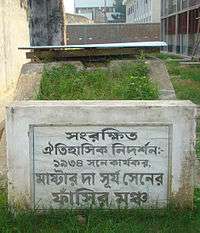Chittagong armoury raid
| Raid on Chittagong Armoury | |||||
|---|---|---|---|---|---|
| |||||
| Commanders and leaders | |||||
| Surya Sen | |||||
The Chittagong Armoury Raid, also known as Chittagong uprising, was an attempt on 18 April 1930 to raid the armoury of police and auxiliary forces from the Chittagong armoury in Bengal province of British India (now in Bangladesh) by armed revolutionaries for Indian independence led by Surya Sen.
The raiders
The raiders were members of revolutionary groups believing in armed uprisings for Indian independence to India's independence from British colonial rule. The group was led by Surya Sen, and included Ganesh Ghosh, Lokenath Bal, Nirmal Sen, Ambika Chakrobarty, Naresh Roy, Sasanka Datta, Ardhendu Dastidar, Harigopal Bal (Tegra), Tarakeshwar Dastidar, Ananta Singh, Jiban Ghoshal, Anand Prasad Gupta, Pritilata Waddedar, Kalpana Dutta, Binod Bihari Chowdhury, Subodh Roy Debi Prasad Gupta and many others.
The plan
Surya Sen devised the strategy of capturing the two main armouries in Chittagong and then destroying the telegraph and telephone office, followed by assassination of members of the "European Club", the majority of whom were government or military officials involved in maintaining the British Raj in India. Firearms retailers were also to be raided, while rail and communication lines were to be cut in order to sever Chittagong from Calcutta.
The raid

The plan was put into action at 10 p.m. on 18 April 1930. The police armoury (in Police Line in Dampara) was captured by a group of revolutionaries led by Ganesh Ghosh, while another group of ten men led by Lokenath Bal took the Auxiliary Forces armory (now old Circuit House). Some sixty-five revolutionaries took part in the raid undertaken in the name of the Hindustan Republican Army, Chittagong Branch. However, they could not locate ammunition. Revolutionaries also succeeded in cutting telephone and telegraph wires and disrupting the movement of the trains; about sixteen of them captured the European club's headquarters (in Pahartali now Railway Office next to Shahjahan Field).
However, the day was Good Friday, and most of the club members were at their homes. Upon learning of the situation, the Europeans were able to get the alarm out to troops, which the revolutionaries had not expected. After the raids, the revolutionary groups gathered outside the police armory where Surya Sen took a military salute, hoisted the National Flag, and proclaimed a Provisional Revolutionary Government. The revolutionaries left Chittagong town before dawn and marched towards the Chittagong hill ranges, looking for a safe place to hide.[1]
Aftermath
After a few days, the police traced some of the revolutionaries. The revolutionaries were surrounded by several thousand troops while they took shelter in Jalalabad hills near Chittagong Cantonment on the afternoon of 22 April 1930.
Over eighty troops and twelve revolutionaries were killed in the ensuing gunfight. Surya Sen dispersed his men to neighboring villages in small groups and the revolutionaries escaped accordingly. A few of the revolutionaries fled to Calcutta while some were arrested. It is however not very likely that 50 revolutionary recruits armed with policemuskets would be able to kill 80 Gurkhas.
Some of the revolutionaries managed to reorganize their broken organization. On 24 September 1932, Debi Prasad Gupta, Manoranjan Sen, Rajat Sen, Swadesh Roy, Phanindra Nandi and Subodh Chaudhary led by Pritilata Waddedar attacked the European Club, killing one woman. But the plan backfired and Debi Prasad Gupta, Manoranjan Sen, Rajat Sen, Swadesh Roy were killed while the other two, Subodh and Phani were wounded and arrested. During 1930-32, 22 officials and 220 others were killed by revolutionaries in separate incidents. Debi Prasad Gupta's brother Ananda Prasad Gupta was sentenced to transportation for life vide judgement.
The armoury raid trial
The mass trial of those arrested during and after the raids concluded in January 1932 and the judgment was delivered on 1 March 1932. Twelve of the defendants were sentenced to deportation for life, two received three-year prison sentences and the remaining 32 individuals were acquitted.
Capture and death of Surya Sen


The Chittagong revolutionary group suffered a fatal blow when Masterda Surya Sen was arrested on 16 February 1933 from Gairala village after a tip-off from an insider of the group. For the reward money, jealousy, or both, Netra Sen told the British Government that Surya Sen was at his house. But before Netra Sen was able to get his 10,000 rupee reward, he was killed by the revolutionaries.
Surya Sen along with Tarekeshwar Dastidar was hanged by the British on 12 January 1934.[2]
Film adaptations
A Bengali movie Chattagram Astragar Lunthan was made on the Chittagong armoury raid in 1949. It was directed by Nirmal Chowdhury.
A Hindi movie, Khelein Hum Jee Jaan Sey was made on the Chittagong armoury raid in 2010. It was directed by Ashutosh Gowarikar starring Abhishek Bachchan and supported by Deepika Padukone. It was based on the book Do and Die: The Chittagong Uprising 1930-34 by Manini Chatterjee.
Another film, Chittagong was made in 2010 and released in October 2012. It was directed by Dr. Bedabrata Pain, a former scientist in NASA who resigned from NASA to make this film. Manoj Bajpai was the lead actor and played the role of Surya Sen.
References
- ↑ Chandra 1989, p. 251-2.
- ↑ Chandra 1989, p. 252.
Sources
- Chandra, Bipan (1989). India's struggle for independence, 1857-1947 (Repr. ed.). New Delhi, India: Penguin Books. ISBN 9780140107814. Retrieved 29 June 2015.
Further reading
- Chatterjee, Manini (2000). Do and Die: The Chittagong Uprising 1930-34, New Delhi: Penguin, ISBN 978-0-14-029067-7.
- Bhattacharya, Manoshi (2012). Chittagong: Summer of 1930, New Delhi: HarperCollins, ISBN 9789350292129.
| Anushilan Samiti |
|---|
 |
|
Influence |
|
Anushilan Samiti
|
|
Notable events |
|
Related topics |
| ||||||||||||||||||||||||||||||||||